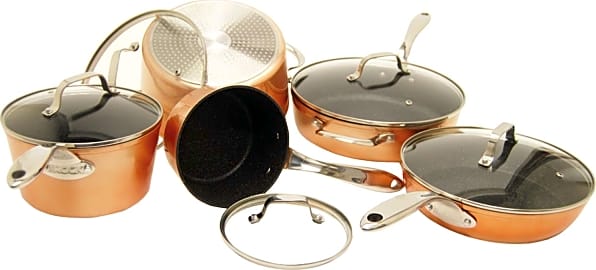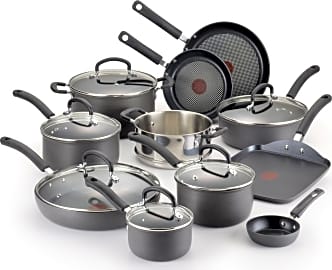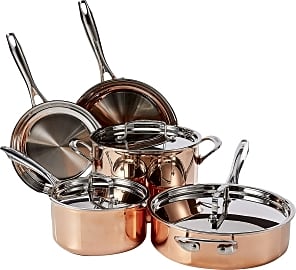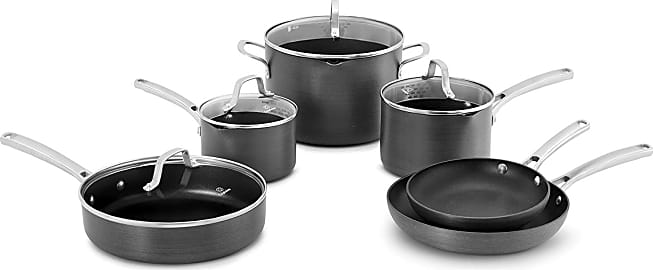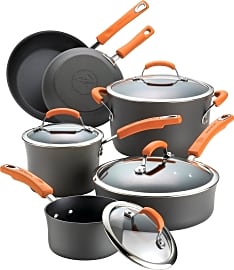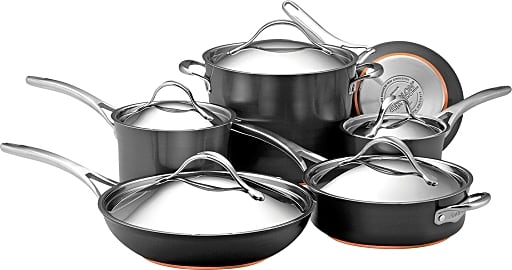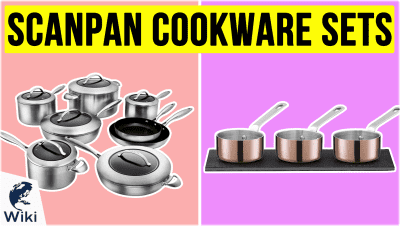The 10 Best Cookware Sets

This wiki has been updated 39 times since it was first published in April of 2015. Professional chefs and occasional cooks alike will find the perfect vessels for their culinary creations in our selection of cookware sets. Even if you just want to boil water and fry an egg, you're going to need some pots and pans. We've included everything from affordable, everyday options to highly dependable pieces that can handle the demands of a bustling restaurant kitchen. When users buy our independently chosen editorial picks, we may earn commissions to help fund the Wiki.
Editor's Notes
July 16, 2021:
Cookware is central to any kitchen, and buying an entire set ensures not only that you have everything you need, but also that they all match and look great together. Our current selections haven't changed since our last update, so the All-Clad D3 Stainless Steel is still the best premium option. If you want stainless steel but don't want to spend an absolute fortune, the Tramontina Gourmet Prima is a good mid-range choice. If you don't need a ton of pans and want to save some money, the Rachael Ray Brights and The Rock by Starfrit are both great choices.
July 13, 2020:
At this time, we've looked for cookware sets that are durable and easy to clean — and most happen to be quite handsome, as a bonus. The All-Clad D3 Stainless Steel and the Tramontina Gourmet Prima still come out on top by virtue of their robust construction, as well as the fact that they're offered in sets of various sizes to suit a range of needs. We still like The Rock by Starfrit, as well, especially since the frying pan offers an excellent nonstick experience, despite not being coated with any chemicals.
To accommodate those who might be looking for an affordable option, we added the Nutrichef Excilon and the Gotham Steel Kitchen in a Box. You shouldn't expect these to be the last pots and pans you ever need to buy, but for those trying to kit out a kitchen on a tight budget, they're worth a look. They each come in several colors, too.
Finally, we've opted to keep the Cuisinart Copper Tri-Ply, although copper pans aren't necessarily for everyone. Even though the interior of these handy pans is lined with tin and so is relatively robust, the exterior can develop a patina, which is unattractive to some. You can usually buff this out, but if you want a set that always looks perfect, with little to no effort, you may want to skip over this one.
March 27, 2019:
Selecting the perfect cookware set is a highly personal experience, both because styles and materials vary greatly and because every cook has his or her own idiosyncratic ways. Nevertheless, we believe that in the majority of situations, the All-Clad D3 Stainless Steel and the Tramontina Gourmet Prima are top choices, with the latter being the more budget-friendly option. Do note that as with any other stainless steel options, these can begin to show rainbow discoloration (caused by high heat). This is neither dangerous nor a defect and can usually be cleaned with vinegar or Bar Keepers Friend. For those who prefer non-stick options, we might suggest The Rock by Starfrit or the Anolon Nouvelle. Choose the former if you need to be able to throw your pans in the dishwasher. Finally, we removed the Lagostina Martellata, as it's debatable as to whether it's durable enough to justify the high cost, and the Duxtop Professional, which doesn't have the most reliable lids.
Special Honors
Hestan NanoBond Titanium Ultimate Each piece in the Hestan NanoBond Titanium Ultimate boasts a cooking surface that's four times harder than standard stainless steel, so you can expect this set to take some abuse for years to come. Plus, the mess-free flared rims make for easy pouring. hestanculinary.com
Le Creuset 11-Piece Ultimate Cast Iron Offered in a wide range of cheery colors, Le Creuset 11-Piece Ultimate Cast Iron is an iconic choice of the highest quality. The enameled cast iron is strong and doesn't require seasoning, while the ergonomic handles make these pieces comfortable to use. lecreuset.com
All-Clad Copper Core 33-Piece The All-Clad Copper Core 33-Piece is a monster of a set — with the hefty price tag to match. But it includes just about everything the serious chef could ask for, from a four-quart chicken fryer to three variously sized frying pans. You can count on the five-ply construction for excellent heating times and temperature control. williams-sonoma.com
How Bonded Metal Changed the Cooking World
So, Ulam started a new company in 1967, All-Clad, making professional quality gourmet cookware with the sandwich metals.
It all started with the Rolls Royce of cookware, All-Clad. To this day, it's still an aspirational brand. It's pricey, sure, but if you take good care of it, it will last a lifetime. Generally considered America's finest cookware, and used by chefs around the world, it's also the first company to make cookware from bonded metals.
Its inventor, John Ulam, was a brilliant metallurgist in mid-century Pennsylvania, and he had a company that made bonded metals for various applications other than cooking. The U.S. government even entrusted his company, Clad Metals, with making dimes, quarters, and half-dollars, and with their conversion from silver to the bonded layers of metals we see in today's coins.
Of his most commercially successful invention, Ulam writes in his patent: "We have discovered a method of cladding metals which overcomes the difficulties of prior art practices and makes it possible to provide close control over the physical properties of the metals in the ultimate composite clad metal and at the same time to control and provide a strong bond between the dissimilar metals forming the clad body." In other words, he discovered a way to clad stainless steel and aluminum together to exploit the best properties of each of the metals.
In yet another stroke of genius from a man who had many, Ulam realized that the properties of bonded metals could revolutionize cookware: Aluminum and copper react with food in a way that can change the way foods taste, and they conduct heat very well. Stainless steel does not react with food, but it does not conduct heat nearly as efficiently. With aluminum or copper sandwiched between two layers of stainless you got a pan that conducts heat without a chemical reaction to the food.
So, Ulam started a new company in 1967, All-Clad, making professional quality gourmet cookware with the sandwich metals. Originally, Ulam slogged it out at trade shows, hawking his cookware to professional chefs and restaurants. Then, one fateful day in 1973, a Bloomingdale's buyer was at one of these trade shows, and picked the brand up for the store's high-end housewares department.
A Guide to the Right Pots and Pans for You
It's a tough decision when you're talking about plunking down a pile of dough on a set of pots and pans. It's personal. If you cook a lot, it's even an intimate decision - one that you probably will have to live with for a long time. It's vital, then, that you understand the differences between the various cookware options and how they'll affect your food.
If you've been reading carefully, you already know that stainless is a poor heat conductor on its own. It will not give consistent heat distribution. Of course, that's why the better option is bonded metal, using stainless on the inside and outside, and aluminum or copper sandwiched in between. A minimum of three layers will give you the best heat distribution with no chemical reaction with food.
A minimum of three layers will give you the best heat distribution with no chemical reaction with food.
The true thoroughbred of the kitchen, copper cookware is gorgeous, and part of the appeal of copper cookware is, obviously, its great beauty. But if you're cooking acidic foods - foods with grains, sugar, dairy - they might pick up a metallic taste.
Aluminum conducts heat like a champ. It's lightweight and affordable, but unfortunately, it's highly reactive. If you cook with just aluminum, you risk discolored pots and food, as well as a metallic taste. Plus, the metal is soft, so it dings pretty easily. Anodized aluminum is harder, and preferable in cookware.
Nonstick cookware tends to be very non-reactive, and food slides right out of the pan. The surface will chip and scratch over time, however, no matter how careful you are. And PTFE, the most common nonstick material, contains PFCs, which scientists say might cause liver damage, cancer, developmental problems, and possibly early menopause.
We can't ignore cast iron in the cookware materials conversation, although a whole set of the stuff would be unwieldy and ultra-heavy, at best. Nonetheless, a home chef would have one or two of these hanging around the kitchen, no matter what the "set" is made of. Cast iron is relatively cheap, incredibly durable, and, if properly seasoned, nonstick. But, like its copper and aluminum cousins, cast iron is reactive with acidic food, though some companies get around this by using an enamel coating.
How to Clean Stainless Steel Pots and Pans
Let's fess up here: We all want that stainless steel kitchen. But only if it will gleam like new forever. Magically. Effortlessly. Without scrubbing and scratches. We don't want to invest without a guarantee that the pricey pots will sparkle and shine on demand.
Here's a little secret: It's not as hard to keep stainless steel looking good as some would like you to think. You just have to be attentive.
Some people say boiling tomato juice will remove particularly bad stains.
So, the more industrial end of the cleaning spectrum uses products like Bar Keepers Friend, which uses oxalic acid as its main ingredient. (Sounds scary, but it comes from the flowering wood sorrel). Simply make a paste of the powder with a little water, rub it in the pot, let it sit. Or you can use it like a cleanser, and, with a sponge and a little elbow grease, scrub.
Natural options include boiling water in the pot or pan for about 20 minutes, adding salt once the water starts boiling. Allow it to set for four hours. Then scrub.
Or, use baking soda and vinegar, or even lemon juice, which you can mix with water and boil if you like, and let the chemical reaction do all the work for you.
Some people say boiling tomato juice will remove particularly bad stains. But why bother, what with the other less expensive options?



